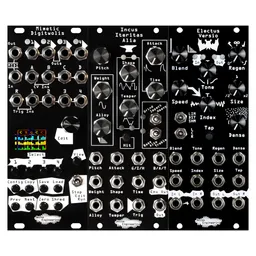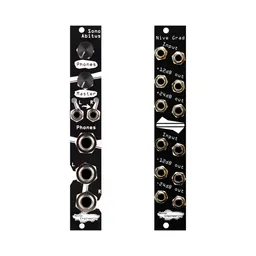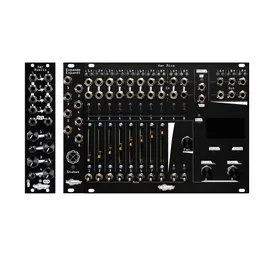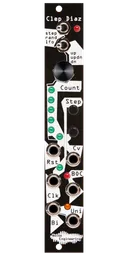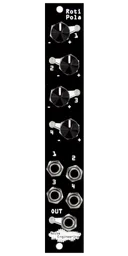So far in our Getting Started series, we’ve touched on some basic concepts having to do mainly with generating sound. However, Eurorack really starts to get interesting when we add some modulation. Today, we’ll take a look at a few of the most common types of modulation, and some ways they can be used and manipulated to make our patches more interesting.
Control voltage: making things interesting
In modular, changes over time are generally created either with our hands, or with control voltage (CV). CV can take many forms, and it can come from many different places. Broadly speaking, if we want something to move automatically, we’ll do that with CV. We can use CV to automate the opening and closing of a filter, to change the timbre of a sound, just help a patch evolve, and so much more.
LFOs
In our first post in this series, we talked about oscillators. Oscillators are often used as our sound sources, but they can also be used to modulate parameters in our patch. If we just plug an oscillator into another, that is audio-rate modulation; we’ll talk about that another day. Today we’ll focus on what happens when you turn the frequency (pitch) way down below where we can hear it and use that for slow modulation. Modules that do this are called LFOs, or low frequency oscillators. n fact, many audio oscillators even have an LFO setting (or can just be turned down far enough to act as an LFO). Just like an audio oscillator, LFOs can have different waveforms, and those waveforms will modulate things in different ways. For example, a sine wave will continuously move up and down at an even speed, while a saw wave will ramp up and then jump down.

LFOs can be as simple as a freerunning oscillator that continuously oscillates at whatever frequency you set, or they can be a little bit more complicated: some have more unusual output shapes, and some can do things like sync to a clock or be controlled by other CV sources.
Envelope generators
Earlier on in this series, we talked about how envelopes can be used to control the dynamics of a voice in a patch. However, envelopes are also one of the most useful types of CV generators for all sorts of things. Since they can react to a sequencer or a keyboard, they’re a great way to create musical modulation. A common theme is to use two envelopes in a subtractive voice patch: one modulates a VCA to control dynamics, and the other modulates a filter to create timbral changes as the note is played. Envelopes can be used for a whole variety of things, though: for instance, an envelope can modulate the pitch of an oscillator when synthesizing things like kick drums to create the impact of a sound. Or, it can modulate something like a wavefolder or a distortion module to change our sound as we play.
We went over envelope generator basics in detail in our post about envelopes and VCAs, so if you want more details, head over there!
Stepped CV
LFOs and envelope generators generally give us smooth CV. Sometimes that’s what we want, but other times, we want to create sudden changes that correspond to a sequence. That’s where CV sequencers come in: they let you set different CV levels per step and run through them in time with a clock.
Some CV sequencers are quantized, meaning that they only output voltages that correspond to musical intervals. Others aren’t, and are more often used to modulate things that need less precision than the pitch of a note, like a filter or a wavefolder. Standalone quantizers exist though, so even these sequencers can be used for pitch!
Mixing
Now, what happens if we want to modulate one thing with a bunch of different things? That’s where mixing comes in. Just like we can mix multiple audio sources together, we can do the same thing with CV. For instance, if we have two different envelope generators triggered by different sequencers, we can mix them together to create more varied modulation. Similarly, we could mix a few LFOs together, at different frequencies, creating an evolving and never-quite-repeating pattern of modulation.
Most CV mixers, like our Roti Pola, offer some sort of level control for each input. The ways we modify CV differs a bit from how we’d control channels on, for instance, an audio mixer -- we’ll be going over all the ways you can modify CV in the next post in this series.
Modulate all the things
Control voltage is, arguably, the most important part of any Eurorack patch. If there’s a CV input on a module, try patching into it -- the worst that can happen is it won’t sound quite how you like. In my patches, I often use a mult to send a single source of CV to multiple destinations on a single module just to make sure that every note is a little different. When in doubt, add modulation!
For the advanced patcher: Pitch sequencing LFOs
Many oscillators have LFO modes, and that means there are lots of LFOs that can be “pitch” sequenced. Now, obviously, we can’t hear LFOs the same way we can hear audio oscillators, but if we think about pitch in terms of frequency relationships instead of notes, lots of possibilities open up for fine control in predictable ways.
For instance, an octave change in pitch corresponds to a doubling or halving of frequency: that means that if we transpose an LFO up an octave, it’ll modulate our CV destination exactly twice as fast. If we’re sequencing a voice that has some LFO modulation in it, splitting the pitch sequence up and patching a copy to the “pitch” input on our LFO will give us some really interesting effects -- the higher the note, the faster the modulation. This is a fantastic and creative effect that makes our instruments respond predictably, but sound more varied.
This is one of my favorite techniques for making reese basses in slightly nontraditional ways. Generally wobbles in that type of sound come from two separate pitches beating off of each other, but having a “pitched” modulation source opens up a lot of possibilities for new types of sounds that follow a traditional architecture.
Looking for modules?
Here are just a few modules that can perform some of the functions we've been chatting about. There are always lots of choices in modular!
XAOC Batumi: Quad LFO with lots of outputs.
Noise Engineering Clep Diaz: Stepped or smooth CV generator.
Intellijel Dual ADSR: Two ADSR envelopes.
Noise Engineering Roti Pola: Four-channel CV mixer.
